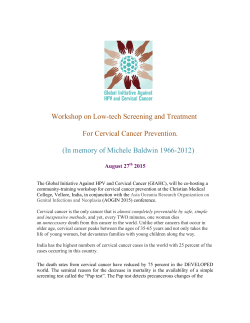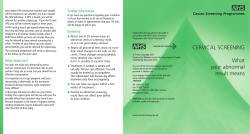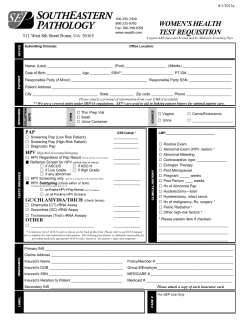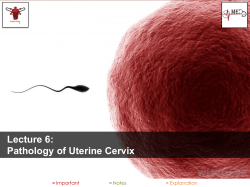
Cervical Ectropion
Cervical Ectropion What is a Cervical Ectropion? The cervix (or “neck” of the womb) is the lowest part of the uterus and hangs down into the upper part of the vagina. The cervix is covered by two different types of skin. One type is similar to the skin on the rest of your body and is called squamous epithelium - this is many cell layers thick and covers most of the outside of the cervix. However, the cervical canal is lined by a very thin layer of tissue called columnar epithelium. Where these two layers meet is known as the squamo-columnar junction and it is from this part of the cervix that cervical smears are taken. A cervical ectropion is the condition in which there is a raw-looking area on the cervix. It occurs when the thin inner lining of the cervix comes out onto the part of the cervix that can usually be visualised during a speculum examination. It is related to a hormone called oestrogen and is therefore more common in young women, pregnant women and those taking oral combined contraceptive pills. In these women, the cervix has a tendency to open outwards. This reveals more of the thin skin which tends to produce more discharge, it tends to bleed when scraped or rubbed during intercourse or at the time of taking a cervical smear. 1 What are the symptoms you might have and when do you need treatment? It may cause you no problems at all and often requires no treatment; however, sometimes you may experience increased vaginal discharge or bleeding, especially after any contact with the cervix such as during sexual intercourse or when having a cervical smear. What does the treatment involve? The ectropion can easily be treated with cautery (diathermy). This treatment is under local anaesthetic (when you are awake). What are the benefits of treatment? Most women find significant improvement in their symptoms. What would happen if I do not have treatment? Over a period of time the thin skin gradually changes into the thicker skin, how long this takes is variable. You may therefore continue to have vaginal discharge, post coital and irregular menstrual bleeding. You can be reassured that you will come to no harm, so long as your last smear is within the recommended screening schedule was normal. What are the risks and side effects of treatment? • • • • • Infection – 5 out of every 100 women may develop an infection. If the vaginal discharge becomes smelly and you develop a raised temperature, you should contact your GP for treatment with antibiotics Small risk of bleeding, which is usually controlled during the procedure. A further risk of secondary bleeding occurs 7-10 days after the treatment. If very heavy contact the colposcopy clinic or your local A&E service after hours. The procedure does not affect your ability to conceive There may be some slight abdominal cramping for a few days and brownish or clear discharge for 2 weeks after treatment. A minority of women find no improvement in their symptoms. Advice before treatment? • If you have vaginal bleeding on your appointment date, please call us for advice. • You can eat and drink normally before coming to the clinic. • If you have a coil (IUCD) the doctor may take it out at the time of treatment. You should use an additional method of contraception (condoms) prior to treatmentand continue with it until you are able to have the coil replaced. 2 How long will I be in hospital? You will be able to go home immediately after the procedure, as the treatment is usually done in specialised clinics. What happens after the treatment? • • • • • • • You may suffer period pain or cramp for a few hours following the procedure. You can take mild painkillers for this. (paracetamol. Ibuprofen, naproxen). Bleeding/discharge. Initially, it is like a light period before changing to a pink, then brown discharge. It may last for up to a month. Your next period may arrive earlier and be heavier than normal. Your periods will then return to normal. Most women feel well enough to continue their daily routine. You can drive and resume work immediately, but some women feel a little shaky after the treatment. If this is the case we would advise you to take things easy for the rest of the day and arrange for a friend to accompany you home after treatment Your cervix is susceptible to infection whilst healing. For this reason we advise you to avoid sex, tampons, vaginal douching, swimming and long baths for 4 weeks. If you travel abroad you may not be covered by insurance should any complications related to the treatment arise. Please check with your insurance company. You can eat and drink normally. When and where should I seek advice or help? • • • Heavy bleeding, with blood clots the size of your palm. A smelly or heavy discharge. Pain in the lower abdomen, not responding to simple painkillers. If you have any of these symptoms you should contact your GP. Alternatively, you can ring the contact numbers printed below. If you are unwell after working hours contact your local A&E service. Other sources from where to obtain information www.cancerscreening.nhs.uk/cervical www.nhsdirect.nhs.uk Contact numbers Wexham Park Colposcopy clinic 01753 634526 Heatherwood Colposcopy clinic 01344 877392 Out of clinic hours: Ward 20, Wexham Park 01753 634535 3 Title of leaflet: Cervical Ectropion Reference No: L/062/1 Issue Date: January 2013 Review date: January 2016 Compiled by: Dr S Nayak : Mr A Wagley (Lead Colposcopist) Legal Notice Please remember that this leaflet is intended as general information only. We aim to make the information as up to date and accurate as possible but please be warned that it is always subject to change. Please therefore always check specific advice on any concerns you may have with your doctor. Heatherwood Hospital London Road Ascot Berkshire SL5 8AA Tel 01344 623333 Fax 01344 874340 4 Wexham Park Hospital Wexham Street Slough Berkshire SL2 4HL Tel 01753 633000 Fax 01753 634848
© Copyright 2025





















